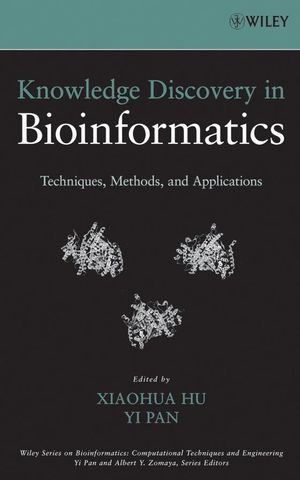Knowledge Discovery in Bioinformatics: Techniques, Methods, and ApplicationsISBN: 978-0-471-77796-0
Hardcover
416 pages
June 2007
 |
||||||
Preface.
1 Current Methods for Protein Secondary-Structure Prediction Based on Support Vector Machines (Hae-Jin Hu, Robert W. Harrison, Phang C. Tai, and Yi Pan).
1.2 Support Vector Machine Method.
1.3 Performance Comparison of SVM Methods.
1.4 Discussion and Conclusions.
2 Comparison of Seven Methods for Mining Hidden Links (Xiaohua Hu, Xiaodan Zhang, and Xiaohua Zhou).
2.1 Analysis of the Literature on Raynaud’s Disease.
2.2 Related Work.
2.3 Methods.
2.4 Experiment Results and Analysis.
2.5 Discussion and Conclusions.
3 Voting Scheme–Based Evolutionary Kernel Machines for Drug Activity Comparisons (Bo Jin and Yan-Qing Zhang).
3.1 Granular Kernel and Kernel Tree Design.
3.2 GKTSESs.
3.3 Evolutionary Voting Kernel Machines.
3.4 Simulations.
3.5 Conclusions and Future Work.
4 Bioinformatics Analyses of Arabidopsis thaliana Tiling Array Expression Data (Trupti Joshi, Jinrong Wan, Curtis J. Palm, Kara Juneau, Ron Davis, Audrey Southwick, Katrina M. Ramonell, Gary Stacey, and Dong Xu).
4.1 Tiling Array Design and Data Description.
4.2 Ontology Analyses.
4.3 Antisense Regulation Identification.
4.4 Correlated Expression Between Two DNA Strands.
4.5 Identification of Nonprotein Coding mRNA.
4.6 Summary.
5 Identification of Marker Genes from High-Dimensional Microarray Data for Cancer Classification (Jiexun Li, Hua Su, and Hsinchun Chen).
5.1 Feature Selection.
5.2 Gene Selection.
5.3 Comparative Study of Gene Selection Methods.
5.4 Conclusions and Discussion.
6 Patient Survival Prediction from Gene Expression Data (Huiqing Liu, Limsoon Wong, and Ying Xu).
6.1 General Methods.
6.2 Applications.
6.3 Incorporating Data Mining Techniques to Survival Prediction.
6.4 Selection of Extreme Patient Samples.
6.5 Summary and Concluding Remarks.
7 RNA Interference and microRNA (Shibin Qiu and Terran Lane).
7.1 Mechanisms and Applications of RNA Interference.
7.2 Specificity of RNA Interference.
7.3 Computational Methods for microRNAs.
7.4 siRNA Silencing Efficacy.
7.5 Summary and Open Questions.
8 Protein Structure Prediction Using String Kernels (Huzefa
Rangwala, Kevin DeRonne, and George Karypis).
8.1 Protein Structure: Granularities.
8.2 Learning from Data.
8.3 Structure Prediction: Capturing the Right Signals.
8.4 Secondary-Structure Prediction.
8.5 Remote Homology and Fold Prediction.
8.6 Concluding Remarks.
9 Public Genomic Databases: Data Representation, Storage, and Access (Andrew Robinson, Wenny Rahayu, and David Taniar).
9.1 Data Representation.
9.2 Data Storage.
9.3 Data Access.
9.4 Discussion.
9.5 Conclusions.
10 Automatic Query Expansion with Keyphrases and POS Phrase Categorization for Effective Biomedical Text Mining (Min Song and Il-Yeol Song).
10.1 Keyphrase Extraction-Based Pseudo-Relevance Feedback.
10.2 Query Expansion with WordNet.
10.3 Experiments on Medline Data Sets.
10.4 Conclusions.
11 Evolutionary Dynamics of Protein–Protein Interactions (L. S. Swapna, B. Offmann, and N. Srinivasan).
11.1 Class I Glutamine Amidotransferase–Like Superfamily.
11.2 Drifts in Interfaces of Close Homologs.
11.3 Drifts in Interfaces of Divergent Members.
11.4 Drifts in Interfaces at Extreme Divergence.
11.5 Conclusions.
12 On Comparing and Visualizing RNA Secondary Structures (Jason T. L. Wang, Dongrong Wen, and Jianghui Liu).
12.1 Background.
12.2 RSmatch.
12.3 RSview.
12.4 Conclusions.
13 Integrative Analysis of Yeast Protein Translation Networks (Daniel D. Wu and Xiaohua Hu).
13.1 Protein Biosynthesis and Translation.
13.2 Methods.
13.3 Results.
13.4 Conclusions.
14 Identification of Transmembrane Proteins Using Variants of the Self-Organizing Feature Map Algorithm (Mary Qu Yang, Jack Y. Yang, and Craig W. Codrington).
14.1 Physiochemical Analysis of Proteins.
14.2 Variants of the SOM Algorithm.
14.3 Results.
14.4 Discussion and Conclusions.
15 TRICLUSTER: Mining Coherent Clusters in Three-Dimensional Microarray Data (Lizhuang Zhao and Mohammed J. Zaki).
15.1 Preliminary Concepts.
15.2 Related Work.
15.3 The TRICLUSTER Algorithm.
15.4 Experiments.
15.5 Conclusions.
16 Clustering Methods in a Protein–Protein Interaction Network (Chuan Lin, Young-Rae Cho, Woo-Chang Hwang, Pengjun Pei, and Aidong Zhang).
16.1 Protein–Protein Interaction.
16.2 Properties of PPI Networks.
16.3 Clustering Approaches.
16.4 Validation.
16.5 Conclusions.
References.
Index.



